The following collection of practice activity worksheets will help your students learn how to identify and use similes correctly. Activities include completing sentences with the correct simile from a given list, identifying similes within given sentences, identifying which things are being compared by a simile, differentiating between similes and metaphors, and more. Metaphors and similes make comparisons, but the difference between the two are the words that are used. Metaphors state direct comparisons, while similes use words such as like or as. That is the dead give away on that. They are often confused with metaphors which are also used to make comparisons. The specific difference between these two are that similes us the two words (like or as) we mentioned earlier to form the contrast between things. Metaphors on the other hand, do not use these words. Similes are also used in situations that call for a simple meaning or saying. Metaphors are meant to be used in situations that require having deeper thought and emotions.
Printable Simile Worksheets
Click the buttons to print each worksheet and answer key.

Which Is It? Worksheet
Read each sentence below. Does it contain a simile (S) or a metaphor? (M) Write the correct answer on the line.


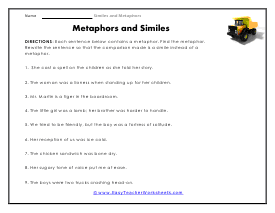
In the Sentence
Each sentence below contains a metaphor. Show us where it is located. Rewrite the sentence so that the comparison made is a simile instead of a metaphor.
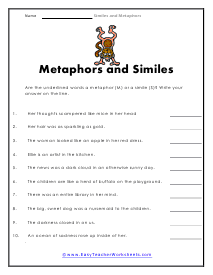
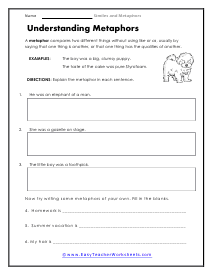
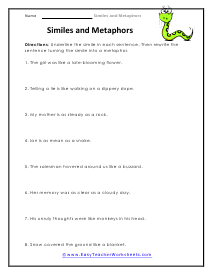
Sentence Rewrites
Underline the simile in each sentence. Then rewrite the sentence turning the simile into a metaphor.
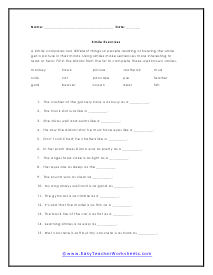
Practice Exercises
Using similes make sentences more interesting to read or hear. Fill in the blanks from the list to complete these well known ones.
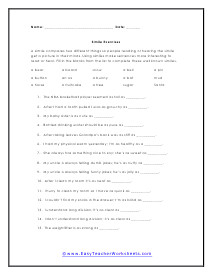
Whole Bunch of Things To Compare
Use the similes in the word bank to complete each of the sentences.
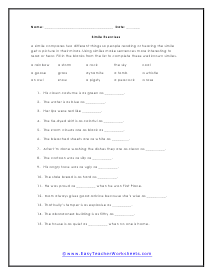
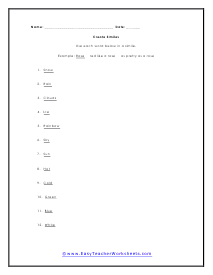
Creating Your Own Use of This Worksheet
You will need to think for a while before completing this one.
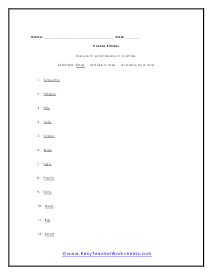
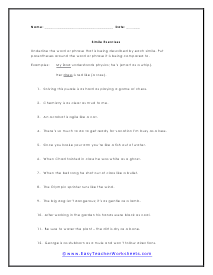
Simile Transfer Exercise
Underline the word or phrase that is being described by each simile. Put parentheses around the word or phrase it is being compared to. =
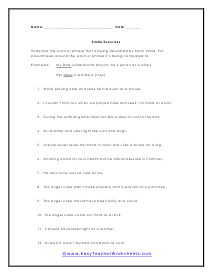
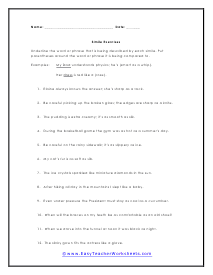
What Are Similes and How to Use Them
As cool as a cucumber, as dead as a doornail, as slow as a sloth… these are all examples of similes. A simile compares two different things with similar characteristics. Not to be confused with metaphors, they can be identified with the words as and like.
Similes are one device authors can use to compare two different things. They are easily identified because they use the words "like" or "as" in the comparison. The use of this literary device can bolster the readers imagination and it can make the work more vivid in their mind. This is one of the several different opportunities where the author can connect better with their reader. Many fans of reading often gravitate towards the work of authors that use this technique.
The following is a list of some similes that are used in conversation and writing.
- Fight like cats and dogs
- Slept like a log
- Fits like a glove
- Sparkle like diamonds
- Light as a feather
- Tough as nails
- Hurts like the devil
- Like watching paint dry
- Works like a charm
- Bright as the sun
How Do They Work?
Similes make use of hyperbole, or exaggeration, to show emphasis. In the simile, “she was light as a feather," the writer doesn't mean that the subject was actually as light as a feather, but they're using the simile to show comparison and develop a persuasive description.
They add a fun element to the writing by making it more interesting without losing any clarity. Readers enjoy the comparisons made through similes, which are often hard to understand using metaphors.
They have the ability to make stories, essays, and novels more creative and descriptive. They have the power to conjure strong images and effective descriptions compared to adjectives or even the actual descriptions of things.
They can generate mental connections, link emotions to the subject, or even enhance specific features. An integral part of dialogues, similes are common in daily conversation as well as poetry.
The Importance of Using Them
Create Imagery
Writers can create imagery through figurative descriptions using similes. When two different things are compared to show similarity, the reader can create an image to develop a greater understanding of the meaning behind the writer's words.
Generate Thought and Emotion
When as a literary device, a simile invokes the reader to think about the very logic behind the comparison. The resultant thoughts create emotions when the truthfulness of the comparison dawns on the reader - something they may not have understood without the absence of that simile.
Although similes are a great way to spruce up the writing, too many of them end up confusing the reader. Use them sparingly in your literary work.
How To Write a Good One?
To write your similes, make use of this easy formula "A is like B." You already know you have to make a comparison, so think of things with similar properties.
- Keep Them Simple
Many good similes use easy-to-understand, everyday examples. Make sure you're using the right example for the context, character, and scene of your story.
- Consider the Visuals
Make sure the image you're trying to paint in your reader's mind is as vivid and descriptive as possible. After all, that's the main purpose of the simile!
Examples of Similes in Literature
Here are some popular examples of using similes in literature:
1. "She entered with an ungainly struggle, like some huge awkward chicken, torn, squawking, out of its coop." Sir Arthur Conan Doyle, The Adventure of the Three Gables
2. "I wandered lonely as a cloud that floats on high o'er vales and hills." William Wordsworth, Daffodils
3. "Life is like riding a bicycle. To keep your balance, you must keep moving." Albert Einstein
4. "Not forgiving is like drinking rat poison and then waiting for the rat to die." Anne Lamott
5. "Writing a novel is like driving a car at night. You can see only as far as your headlights, but you can make the whole trip that way." E.L. Doctorow
6. "That always seemed so ridiculous to me, that people want to be around someone because they're pretty. It's like picking your breakfast cereal based on color instead of taste." John Green
Where Can You Use Similes?
Similes are very common in literature, creative pieces, advertisement, nursery rhymes, and lyrics of songs, such as:
1. "Is love a tender thing? It is too rough, / too rude, too boisterous, and it pricks like thorn."
Romeo Juliet
2. "The Honda's ride is as smooth as a gazelle in the Sahara. Its comfort is like a hug from Nana."
Honda Cars
3. "Twinkle, twinkle, little star,
How I wonder what you are!
Up above the world so high,
Like a diamond in the sky."
Nursery Rhyme
4. "Like a child, you whisper softly to me
You're in control just like a child
Now I'm dancing
It's like a dream, no end, and no beginning
You're here with me; it's like a dream."
Like A Prayer by Madonna
How To Use Similes?
The similes used in the sentences below provide the perfect example of how to use similes in writing.
1. As black as coal:
Her heart is as black as coal after constantly being jealous.
2. As blind as a bat:
My mother is as blind as a bat without her glasses.
3. As cool as a cucumber:
While we all panicked after the car accident, Nora was as cool as a cucumber.
4. As brave as a lion:
While stuck in the thunderstorm, the captain was as brave as a lion.
5. Cunning like a fox:
Don't trust her; she is cunning like a fox.
6. As cold as ice:
The expression on his face was as cold as ice.
7. As busy as a bee:
The school administration was as busy as a bee on the morning of the final event.
8. As soft as velvet:
My new pillowcases are as soft as velvet.
9. As sharp as a razor:
Although my grandmother is 80 years old, her mind is still as sharp as a razor.
10. As white as snow:
The dress she wore was as white as snow.
11. As white as a ghost:
His face became as white as a ghost when the teacher caught him cheating on the test.
12. As fresh as a daisy:
Rob still looked as fresh as a daisy after a hectic day at work.
13. As stiff as a board:
I am sure she is highly anxious because she stands as stiff as a board on the gate.
14. As proud as a peacock:
Phil is as proud as a peacock after receiving a scholarship offer from one of the prestigious universities to pursue higher education.
15. As gentle as a lamb: My mother may come off as a rude and scary person to others, but she is as gentle as a lamb.
16. This shoe is perfect because it fits like a glove.
17. She can hear like an owl.
18. The little boy, like his father, has blue eyes.
19. She looks like Katy Perry.
20. No one makes a cheesecake as my Nana does.

